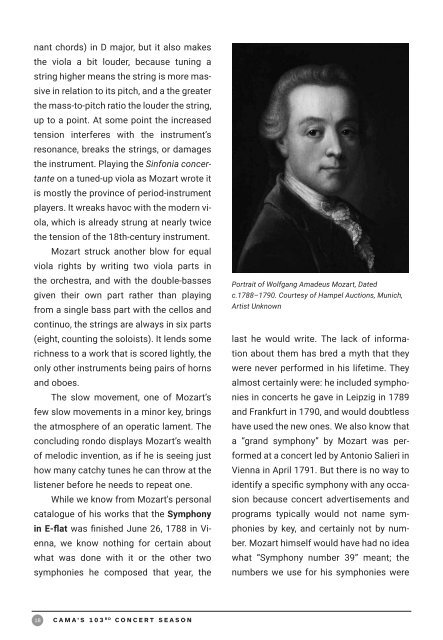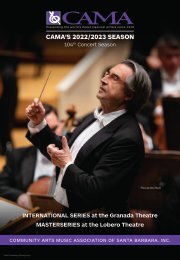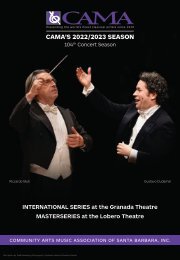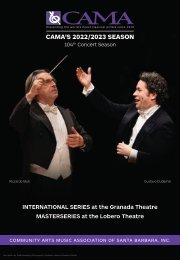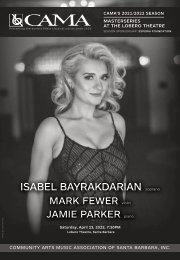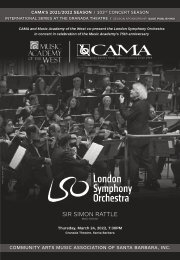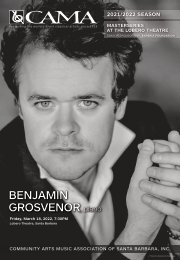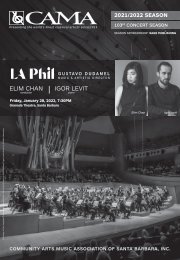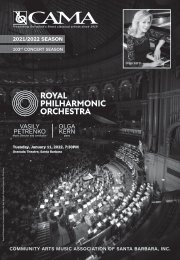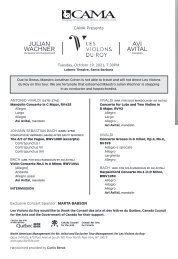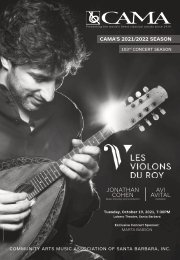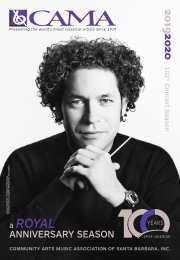CAMA Presents English Baroque Soloists ⫽ John Eliot Gardiner, conductor ⫽ Tuesday, April 12, 2022 ⫽ The Granada Theatre, Santa Barbara, California ⫽ 7:30PM
TUESDAY, APRIL 12, 2022, 7:30PM ENGLISH BAROQUE SOLOISTS JOHN ELIOT GARDINER, conductor Kati Debretzeni, violin Fanny Paccoud, viola Almost inexcusably absent from the pantheon of great conductors appearing in Santa Barbara during CAMA’s long history, John Eliot Gardiner will at last grace the Granada stage directing the English Baroque Soloists, the preeminent period-instrument chamber ensemble founded by the maestro himself in 1978. Arguably the foremost living interpreter of 17th‑ and 18th‑century choral and orchestral repertoire, John Eliot Gardiner is also the Founder and Director of the Monteverdi Choir and the Orchestre Révolutionnaire et Romantique. With these and other ensembles, he has recorded more than 250 albums; among them are benchmark recordings of the Monteverdi Vespers and Bach B‑minor Mass, the complete Beethoven symphony cycle on period instruments, and each and every Bach sacred cantata. In his spare time, the prodigious maestro runs an organic farm at Springhead near Fontmell Magna in North Dorset. PROGRAM: HAYDN: Symphony No.103 in E‑flat Major, “The Drumroll,” H.1/103 MOZART: Sinfonia Concertante for Violin, Viola and Orchestra in E‑flat Major, K.364 (320d) MOZART: Symphony No.39 in E‑flat Major, K.543
TUESDAY, APRIL 12, 2022, 7:30PM
ENGLISH BAROQUE SOLOISTS
JOHN ELIOT GARDINER, conductor
Kati Debretzeni, violin
Fanny Paccoud, viola
Almost inexcusably absent from the pantheon of great conductors appearing in Santa Barbara during CAMA’s long history, John Eliot Gardiner will at last grace the Granada stage directing the English Baroque Soloists, the preeminent period-instrument chamber ensemble founded by the maestro himself in 1978. Arguably the foremost living interpreter of 17th‑ and 18th‑century choral and orchestral repertoire, John Eliot Gardiner is also the Founder and Director of the Monteverdi Choir and the Orchestre Révolutionnaire et Romantique. With these and other ensembles, he has recorded more than 250 albums; among them are benchmark recordings of the Monteverdi Vespers and Bach B‑minor Mass, the complete Beethoven symphony cycle on period instruments, and each and every Bach sacred cantata. In his spare time, the prodigious maestro runs an organic farm at Springhead near Fontmell Magna in North Dorset.
PROGRAM:
HAYDN: Symphony No.103 in E‑flat Major, “The Drumroll,” H.1/103
MOZART: Sinfonia Concertante for Violin, Viola and Orchestra in E‑flat Major, K.364 (320d)
MOZART: Symphony No.39 in E‑flat Major, K.543
Create successful ePaper yourself
Turn your PDF publications into a flip-book with our unique Google optimized e-Paper software.
nant chords) in D major, but it also makes<br />
the viola a bit louder, because tuning a<br />
string higher means the string is more massive<br />
in relation to its pitch, and a the greater<br />
the mass‐to‐pitch ratio the louder the string,<br />
up to a point. At some point the increased<br />
tension interferes with the instrument’s<br />
resonance, breaks the strings, or damages<br />
the instrument. Playing the Sinfonia concertante<br />
on a tuned‐up viola as Mozart wrote it<br />
is mostly the province of period‐instrument<br />
players. It wreaks havoc with the modern viola,<br />
which is already strung at nearly twice<br />
the tension of the 18th‐century instrument.<br />
Mozart struck another blow for equal<br />
viola rights by writing two viola parts in<br />
the orchestra, and with the double‐basses<br />
given their own part rather than playing<br />
from a single bass part with the cellos and<br />
continuo, the strings are always in six parts<br />
(eight, counting the soloists). It lends some<br />
richness to a work that is scored lightly, the<br />
only other instruments being pairs of horns<br />
and oboes.<br />
The slow movement, one of Mozart’s<br />
few slow movements in a minor key, brings<br />
the atmosphere of an operatic lament. The<br />
concluding rondo displays Mozart’s wealth<br />
of melodic invention, as if he is seeing just<br />
how many catchy tunes he can throw at the<br />
listener before he needs to repeat one.<br />
While we know from Mozart's personal<br />
catalogue of his works that the Symphony<br />
in E‐flat was finished June 26, 1788 in Vienna,<br />
we know nothing for certain about<br />
what was done with it or the other two<br />
symphonies he composed that year, the<br />
Portrait of Wolfgang Amadeus Mozart, Dated<br />
c.1788–1790. Courtesy of Hampel Auctions, Munich,<br />
Artist Unknown<br />
last he would write. The lack of information<br />
about them has bred a myth that they<br />
were never performed in his lifetime. They<br />
almost certainly were: he included symphonies<br />
in concerts he gave in Leipzig in 1789<br />
and Frankfurt in 1790, and would doubtless<br />
have used the new ones. We also know that<br />
a “grand symphony” by Mozart was performed<br />
at a concert led by Antonio Salieri in<br />
Vienna in April 1791. But there is no way to<br />
identify a specific symphony with any occasion<br />
because concert advertisements and<br />
programs typically would not name symphonies<br />
by key, and certainly not by number.<br />
Mozart himself would have had no idea<br />
what “Symphony number 39” meant; the<br />
numbers we use for his symphonies were<br />
18 <strong>CAMA</strong>'S 103 RD CONCERT SEASON


